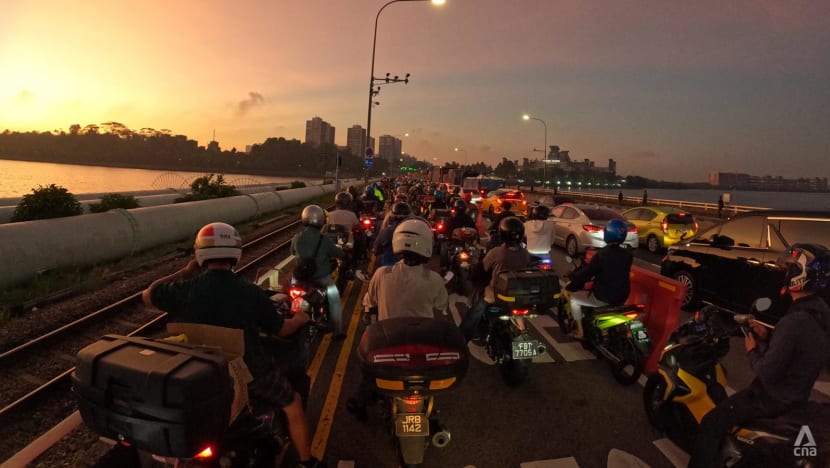Commentary: Singapore, Malaysia commuters have a simple birthday wish for the Causeway
As the Johor-Singapore Causeway celebrates 100 years, CNA’s Amir Yusof hopes it can one day shed its image of being congested and jammed.


This audio is generated by an AI tool.
JOHOR BAHRU: As a child in the 90s, travelling across the Causeway in the back of my family car triggered a sense of bittersweet anticipation.
On one hand, it was a vacation road trip - to the pristine beaches of Terengganu, the cool highlands of the Klang Valley, or even a day trip to Johor Bahru to shop and eat. On the other hand, there was the dread of having to sit through four hours of bumper-to-bumper traffic, desperately hoping no urgent bathroom visits were needed.
Almost three decades later as the Causeway celebrates its 100th birthday, congestion remains a perennial problem, especially for Malaysian workers who travel across the Johor Strait almost daily.
As a journalist, I have followed Causeway crossings of almost every kind - each with its own troubles.
Thousands of motorcyclists wait in the exhaust fumes and cacophony of honks for immigration lanes to clear. Causeway bikers call this stifling experience “kandang kerbau”, or cattle pen.
Pedestrians who insist on walking across the 1.05km bridge undertake a hazardous journey. There is no walkway on some parts of the Malaysian side and they are forced to dodge speedy motorcycles, cars and cargo trucks.
Braving this is better than sitting in buses at a standstill and being late for work, they said.
Truck drivers who deliver fresh vegetables from Cameron Highlands to Singapore may endure eight to 15-hour round trips.
Considering the Causeway’s critical and iconic role in our lives, it is unfortunate we have been unable to satisfyingly improve connectivity and convenience.
CHIPPING AWAY AT CAUSEWAY CONGESTION PROBLEM
As plans for the Johor-Singapore Special Economic Zone (SEZ) firm up and more people and companies become interconnected, crossing the Causeway risks becoming more painful. Singapore’s Immigration and Checkpoints Authority expects traffic volume to grow close to 40 per cent by 2050, with a daily average of about 400,000 travellers.
In all fairness, the situation has improved slightly in recent years. Anecdotally, peak-hour congestion has decreased from an average of two to three hours to between one and two hours.
During the 2023 Singapore-Malaysia Leaders Retreat, Malaysian Prime Minister Anwar Ibrahim said that congestion at the Causeway has eased following efforts by authorities on both sides.
Johor chief minister Onn Hafiz Ghazi has made several in-person spot checks at Johor’s Causeway land checkpoint Bangunan Sultan Iskandar, even posting videos of his surprise visits on social media.
Mr Onn Hafiz has publicly highlighted areas for improvement on the Malaysia side, including ensuring sufficient immigration counters and lanes are open and operational. He has also called for clearance systems to be fixed promptly, such as when the M-Bike system suffered a glitch in March, causing delays for motorcyclists.
Both sides are also rolling out bold measures like the use of QR code immigration clearance, though implementation is currently uneven. It is available only to those travelling by car through the Singapore checkpoint, and is being trialled for those taking buses or motorcycles on the Malaysia side.
Other plans include Singapore’s redevelopment of the Woodlands Checkpoint - which it says will increase clearance capacity and aims to reduce travel time from 60 to 15 minutes.
WHAT CAN BE DONE BETTER
Eradicating congestion completely on one of the world’s busiest land border crossings is an unrealistic proposition. But the situation can surely be improved so that we don’t immediately link the Causeway to frustrating traffic jams.
First, passport-free travel for commuters cannot come sooner.
QR code clearance is a big step towards that vision and it has been welcomed as it saves time and turns the process into an almost frictionless experience.
Expanding this to all modes of transport across both sides of the border would be a big deal for those already commuting regularly, but also ensure the seamless flow of goods and talent for the SEZ.
Passport-free immigration is not new. It has been implemented safely across many more countries in the European Union Schengen Area for nearly 30 years. Singapore is also set to roll out passport-free biometric-based immigration for arriving Singapore residents and departing travellers by the end of 2024 at Changi Airport, Seletar Airport and Marina Bay Cruise Centre.
Phasing out the additional steps to scan passports can accelerate the process and prevent bottlenecks at immigration clearance.
Second, what happened to the idea of a single clearance system? The idea mooted by the Malaysian authorities in early 2023, entails travellers clearing immigration at a single point - either at the country of departure or arrival.
This is one of the salient features of the Johor Bahru-Singapore Rapid Transit System. If this system can be expanded to drivers, motorcyclists and bus passengers at the Causeway, it would possibly reduce travel time by half.
Third, let’s make it safer for those who choose to walk across the border.
In 2020, the Malaysia government mooted the possibility of an air-conditioned walkway with travelators.
The idea has fizzled out but perhaps it is time to resurface a proposal of a continuous walkway or pedestrian lane from one end to another. It would make it the most affordable and least carbon-intensive option of crossing the Causeway safer.
The Causeway is only slightly more than 1 km, which means that most travellers would take around 20 minutes for a one-way journey.
More travellers opting to walk would also decrease the strain on resources needed to clear motorcycles, cars and buses.
MORE THAN A PHYSICAL CONNECTOR
In tandem, these improvements can hopefully alleviate congestion at the Causeway, and one day perhaps travellers can view their journeys with less dread and anxiety - and instead be more excited about their purpose of travel.
Whether one is a Malaysian hoping for a smoother journey to and from work, or a Singaporean shuttling between their retirement home and seeing family, the Causeway will continue to be relevant to millions in the coming years.
The importance of the Causeway truly stood out during the COVID-19 pandemic, when borders closed and the bridge’s function was restricted. It struck the hearts of many Singaporeans and Malaysians.
In August 2021, just days after getting married, I had to leave my wife to report for work in Johor Bahru, with no certainty of when I would see her again. The Causeway separates Singapore and Malaysia by 1.05km but during those days, it felt like a world away.
For all its faults, I am glad that the Causeway is operating again today, connecting the two countries that are important to so many of us.
Amir Yusof is a correspondent at CNA Digital who covers issues related to Johor.




















